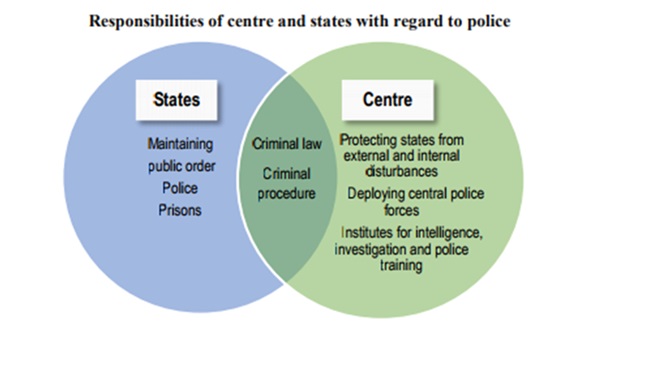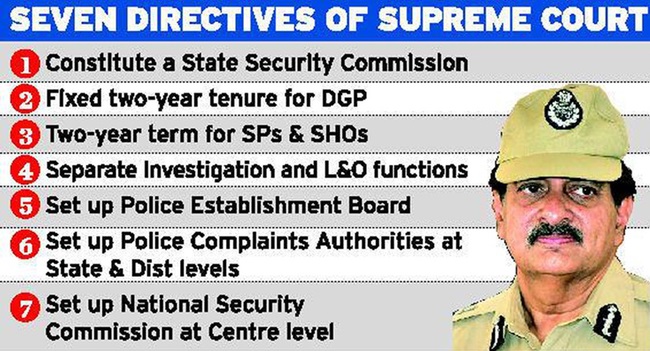Why in News :-
- The Standing Committee on Home Affairs (Chairman: Mr. Anand Sharma) presented its report on ‘Police - Training, Modernisation and Reforms’ on February 10, 2022.
Related Commettees:-
-
- In the past four decades, several commissions have been set up to examine police reforms.
- the National Police Commission (1977, Chair: Mr. Dharma Vira),
- the Committee on Reforms of Criminal Justice System (2003, Chair: Dr. V.S Malimath)
- the Committee on Restructuring of Police (2000, Chair: Mr. K. Padmanabhaiah).
Key Points
Police Reforms (Meaning):
-
- Police reforms aim to transform the values, culture, policies and practices of police organizations.
- It envisages police to perform their duties with respect for democratic values, human rights and the rule of law.
- Police come under the state list of schedule 7 of the Indian constitution.
- Committees/Commissions on Police Reforms:
 Role of Police in maintenance of Public order
Role of Police in maintenance of Public order
- Each state and Union Territory has its own separate police force. Article 246 of the Constitution designates the police as a state subject thereby meaning that state governments frame the Police Acts, rules, and regulations that govern each police force.
- Centre is also allowed to maintain its own police forces to assist the states with ensuring law and order. Therefore, it maintains seven central police forces and some other police organizations for specialized tasks such as intelligence gathering, investigation, research and record-keeping, and training.
Historical background
- Lord Cornwallis (1786-93) introduced reforms in police department.
- The districts were divided into small thanas and an Inspector was appointed in each thana.
- A superior officer with the designation of superintendent of police was appointed in each district to supervise the work of the Inspectors. He raised the salaries of all police officers.
- He separated the Judiciary from executive as a result equal justice could be dispensed to all the people.
- The Police Act-1861, remains the central piece of legislation that governs all aspects of policing in India. It is a British legacy which our legislators find hard to cast off.
- 1861 Act came immediately after 1857 mutiny solely to perpetuate and consolidate British Rule and to keep a check on such civilian upsurge.
- However, to start with, Charles Napier, then Governor of Punjab was the one who felt the need of civilian policing system in 1843.
- Before setting up the police organization, he had two models in his mind-London policing system and Irish Constabulary system. The first one was based on the philosophy that police is public and public is police whereas Irish system was meant to exercise a coercive control and perpetuate exploitation.
- The Irish system was dovetailed with the Indian requirement. This system was later emulated in other provinces also but it gained a pan India face only after the introduction of umbrella Police Act-1861.
- It carries certain characteristics to the disadvantage of the common public: search, seizure and arrest at discretion, distancing and grandeur, authoritarianism, brutality, feudal attitude etc. Among others, IPC, CrPC, Indian Evidence Act-1872 also help in much of the policing function.
 Issues associated with the Police Organization and recommendations
Issues associated with the Police Organization and recommendations
(i) Overburdened police force:-
- Apart from the core function of maintaining law and order, police personnel carry out various other functions such as traffic management, disaster rescue and removal of encroachments.
- The Second Administrative Reforms Commission (2007) recommended that these functions should be carried out by other government departments or private agencies.
- Note that as of January 2016, 24 per cent of sanctioned police posts in India were vacant. This indicates that police personnel may be overburdened, which may have negative consequences on their efficiency and performance.
(ii) Poor quality of investigation:-
- In 2015, the conviction rate for crimes recorded under the Indian Penal Code, 1860 was only 47%.
- The Law Commission (2012) observed that one of the reasons for low conviction rates in India is poor quality of investigation by police.
- The police lack training and expertise required to conduct professional investigations.
- They also have insufficient legal knowledge and inadequate forensic and cyber infrastructure.
- the Second Administrative Reforms Commission (2007) recommended that states should have specialised investigation units within the police force for better investigation of crimes.
(iii) Police accountability:-
- In India, control over the police force vests with the political executive.
- The Second Administrative Reforms Commission (2007) noted that this has to led to abuse of police personnel and interference with their decision-making authority.
- To allow the police operational autonomy while maintaining accountability, the Supreme Court issued guidelines to the central government and state governments (and Union Territories) in the year 2006.
- The guidelines provided for the establishment of three institutions: (i) a State Security Commission, (ii) a Police Establishment Board, and (iii) a Police Complaints Authority.
(iv) Constabulary related issues:-
- The constabulary constitutes 86% of the state police forces.
- A constable's responsibilities are wide-ranging, and are not limited to basic tasks. For example, a constable is expected to exercise his own judgement in tasks like intelligence gathering, and surveillance work, and report to his superior officers regarding significant developments.
- He assists with investigations, and is also the first point of contact for the public. Therefore, a constable is expected to have some analytical and decision-making capabilities, and the ability to deal with people with tact, understanding and firmness.
- The Second Administrative Reforms Commission has further noted that the promotion opportunities and working conditions of constables are poor, and need to be improved. Generally, a constable in India can expect only one promotion in his lifetime, and normally retires as a head constable, which weakens his incentive to perform well. The Commission recommended that the orderly system be abolished across states.
Standing Committee Report on Police Reforms
- The Standing Committee on Home Affairs (Chair: Mr. Anand Sharma) presented its report on ‘Police - Training, Modernisation and Reforms’ in 2022.
Key observations and recommendations of the Committee include:
- Police training: The Committee noted that there is a need to develop soft skills and bring a behavioural change in the police personnel, and train them on understanding and using new technology to solve crimes.
- It recommended transforming several aspects of current training programmes, such as:
- adding programmes on artificial intelligence, robotics, drone technology, forensic and ballistic sciences,
- emphasising on procedures during arrests and rights of the detainee,
- including updates in laws, and
- creating training manuals on the local customs of tribals and other vulnerable groups.
Linkage with universities: The Committee recommended that the Ministry of Home Affairs (MHA) may advise states to link a cluster of police stations to a particular university.
- It also recommended that the MHA may collaborate with state governments to open more police universities in their respective states.
- Common training module: The Committee noted that a common minimum standard of police training must be maintained.
- It recommended that BPR&D may prepare a common training module and shared it among states/union territories (UTs).
- Use of technology by state police: The Committee recommended that the MHA should collaborate with states and UTs to deploy unmanned aerial vehicles for: (i) VVIP security, (ii) surveillance of crime hotspots, (iii) crowd control and riot management, and (iv) disaster management.
- Vacancies in state police forces: The Committee noted that there is a nearly 21% shortfall against the sanctioned strength of 26.2 lakh in state police forces.
- Adoption of Model Police Act, 2006: The Committee noted that the Model Police Act had been forwarded to all the states in 2006. Since then, 17 states have either enacted the Model Act or amended their existing Police Acts.
- Independent police complaint authority: The Committee noted that 31 states/UTs have constituted Police Complaints Authorities (PCA) at the state and district levels for looking into complaints against police officers.
- The Committee also recommended that the MHA may advise states that the internal grievance redressal cell of police should work in a time-bound manner to ensure that the grievances of aggrieved police personnel are addressed in time.
Directions of the Supreme Court in Prakash Singh vs Union of India
In September 2006, the court issued various directions to the centre and states including:

 Role of Police in maintenance of Public order
Role of Police in maintenance of Public order Issues associated with the Police Organization and recommendations
Issues associated with the Police Organization and recommendations